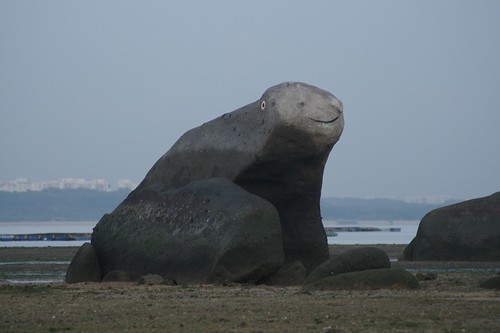NF#1: The tower is 20m tall and allows visitors to get a good view of Chek Jawa and the surrounding areas. Due to it's height, the tower is also a great place to spot birds on nearby trees. This tower can take a maximum of 40 people.
 NF#2
NF#2: The Jejawi Tower is named after the Malayan Banyan (
Ficus microcarpa) growing nearby that was as tall as the tower. The Malayan Banyan is a fig tree. As fig trees produce figs very regularly, they are able to provide regular food supplies for all kinds of animals such as birds and monkeys, unlike other forest trees that fruit perhaps once a year or even once every few years. In fact, such large fig trees play a critical role in providing food and shelter, and studies suggest the number of such fig trees limit the number of animals found in a forest.
Interesting Note: To connect visitors to figs, guides who understand Chinese can ask the visitors if they know the popular oldies "榕树下"(pronounced as Rong Shu Xia), which means "Under the Banyan Tree". Or has anyone eaten "无花果"(pronounced as Wu Hua Guo), which is also a fig. Do explain to the visitors that "无花果" actually do flower, just that the flowers are concealed within the fig. And what they are eating is not really the fruit, but a natural container for the flowers and seeds!
Too Much Information:
Figs are pollinated by tiny fig wasp that are mostly smaller than the head of a pin!
The female wasp somehow finds the correct fig tree in bloom, and sometimes, she must fly a long long way!
To get to the flowers, she squeezes through a tiny little hole in the fig. In the process she loses her wings and most of her antennae.
Usually, there are 3 types of flowers inside the fig:
1. Male flowers near the tiny hole
2. Female flowers with short styles
3. Female flowers with long styles
The male flowers are still immature without pollen. As the female wasp moves around in the fig, she transfers pollen she collected from her previous fig to the female flowers.
She will lay eggs in the female flowers with short styles. After laying the eggs, she dies.
After some time, the baby wasps hatch and feed on the plant tissue surrounding them. The males will hatch first. They are wingless but have strong mouth parts.
Meanwhile, the female flowers with the long styles develop seeds.
Once the male wasps become adults, they will seek out the female wasps and mate with them. After mating, the male wasps will chew and enlarge the tiny hole to create a wider tunnel so that the females can depart without losing their wings. The males usually die soon after they enlarged the tunnel.
As the females leave the fig, they pick up pollen from the male flowers that are now mature.
After they leave, the fig ripens and the walls become yummy to eat. Animals eat the fig and disperse the seeds.
Meanwhile, the brave little female wasp flies on to start the whole cycle then starts all over again.
Additional info on fig and fig wasp:
-
The Fib Web-
The Last Stand of the Male Fig Wasp-
One Fig, One Wasp? Not Always!











